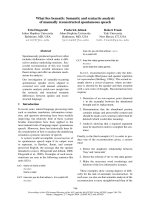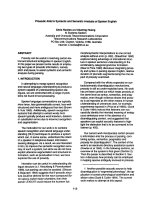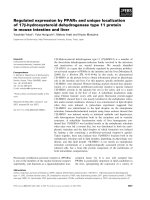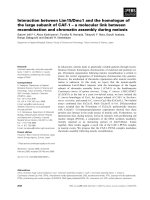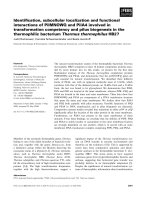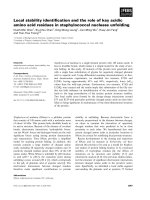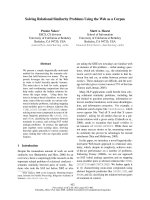Báo cáo khoa học: " Red blood cell transfusions and the risk of acute respiratory distress syndrome among the critically ill: a cohort study" ppt
Bạn đang xem bản rút gọn của tài liệu. Xem và tải ngay bản đầy đủ của tài liệu tại đây (181.48 KB, 9 trang )
Open Access
Available online />Page 1 of 9
(page number not for citation purposes)
Vol 11 No 3
Research
Red blood cell transfusions and the risk of acute respiratory
distress syndrome among the critically ill: a cohort study
Marya D Zilberberg
1
, Chureen Carter
2
, Patrick Lefebvre
3
, Monika Raut
2
, Francis Vekeman
3
,
Mei Sheng Duh
4
and Andrew F Shorr
5
1
School of Public Health and Health Sciences, University of Massachusetts, Amherst, P.O. Box 303, Goshen, MA 01032, USA
2
Ortho Biotech Clinical Affairs, LLC, 430 Route 22 East, Bridgewater, NJ 08807, USA
3
Groupe d'analyse, 1080 Beaver Hall Hill, Suite 1810, Montreal, Quebec, H2Z 1S8, Canada
4
Analysis Group, 111 Huntington Avenue, Tenth Floor, Boston, MA 02199, USA
5
Washington Hospital Center, 110 Irving Street, NW, Washington, DC 20010, USA
Corresponding author: Marya D Zilberberg,
Received: 28 Feb 2007 Revisions requested: 29 Mar 2007 Revisions received: 11 Apr 2007 Accepted: 6 Jun 2007 Published: 6 Jun 2007
Critical Care 2007, 11:R63 (doi:10.1186/cc5934)
This article is online at: />© 2007 Zilberberg et al.; licensee BioMed Central Ltd.
This is an open access article distributed under the terms of the Creative Commons Attribution License ( />),
which permits unrestricted use, distribution, and reproduction in any medium, provided the original work is properly cited.
Abstract
Introduction Recent data indicate that transfusion of packed
red blood cells (pRBCs) may increase the risk for the
development of acute respiratory distress syndrome (ARDS) in
critically ill patients. Uncertainty remains regarding the strength
of this relationship.
Methods To quantify the association between transfusions and
intensive care unit (ICU)-onset ARDS, we performed a cohort
study within Crit, a multicenter, prospective, observational study
of transfusion practice in the ICU which enrolled 4,892 critically
ill patients in 284 ICUs in the United States. Diagnostic criteria
for ARDS were prospectively defined, and we focused on
subjects without ARDS at admission. The development of
ARDS in the ICU served as the primary endpoint.
Results Among the 4,730 patients without ARDS at admission,
246 (5.2%) developed ARDS in the ICU. At baseline, ARDS
cases were younger, more likely to be in a surgical ICU, and
more likely to be admitted with pneumonia or sepsis than
controls without ARDS. Cases also were more likely to have a
serum creatinine of greater than 2.0 mg/dl (23% versus 18%)
and a serum albumin of less than or equal to 2.3 g/dl (54%
versus 30%) and were more severely ill upon ICU admission as
measured by either the APACHE II (Acute Physiology and
Chronic Health Evaluation II) or SOFA (Sequential Organ
Failure Assessment) score (p < 0.05 for all). Sixty-seven percent
and 42% of cases and controls, respectively, had exposure to
pRBC transfusions (p < 0.05), and the unadjusted odds ratio
(OR) of developing ARDS in transfused patients was 2.74 (95%
confidence interval [CI], 2.09 to 3.59; p < 0.0001) compared to
those never transfused. After age, baseline severity of illness,
admitting diagnosis, and process-of-care factors were adjusted
for, the independent relationship between pRBC transfusions
and ICU-onset ARDS remained significant (adjusted OR, 2.80;
95% CI, 1.90 to 4.12; p < 0.0001).
Conclusion Development of ARDS after ICU admission is
common, occurring in approximately 5% of critically ill patients.
Transfusion of pRBCs is independently associated with the
development of ARDS in the ICU.
Introduction
Acute respiratory distress syndrome (ARDS) remains a fre-
quent complication of critical illness and is associated with
significant morbidity and mortality. Its age-adjusted incidence
rate in the United States exceeds 85 cases per 100,000 per-
son-years, and the case fatality rate is near 40% [1]. Illustrating
its burden, Rubenfeld and colleagues [1] estimated that ARDS
leads to 200,000 intensive care unit (ICU) admissions annu-
ally and necessitates 3.6 million inpatient days of care.
Multiple insults can lead to ARDS and range from sepsis to
trauma [2-5]. Because the manner in which care is delivered
to at-risk patients may contribute to ARDS development, there
is a need to better understand process-of-care variables in
APACHE II = Acute Physiology and Chronic Health Evaluation II; ARDS = acute respiratory distress syndrome; CI = confidence interval; ICU = inten-
sive care unit; OR = odds ratio; pRBC = packed red blood cell; SIRS = systemic inflammatory response syndrome; SOFA = Sequential Organ Failure
Assessment; TRALI = transfusion-related acute lung injury.
Critical Care Vol 11 No 3 Zilberberg et al.
Page 2 of 9
(page number not for citation purposes)
order to identify those factors associated with an increased
risk for ARDS which may be amenable to intervention. Packed
red blood cell (pRBC) transfusion represents one specific
potential aspect of care in the ICU which may be linked to
ARDS. Transfusion-related acute lung injury (TRALI), whose
incidence may be 1 in 5,000 pRBC units transfused, has long
been recognized as a subtype of ARDS and is generally asso-
ciated with better outcomes than non-TRALI ARDS [6,7].
Beyond TRALI, though, there is mounting evidence suggest-
ing a nexus between pRBC exposure and ARDS [8-10]. For
example, in a study of a conservative transfusion strategy,
Hébert and colleagues [8] reported that patients randomly
assigned to a higher hemoglobin target were more likely to
develop ARDS. Similarly, Gong and colleagues [9], in an anal-
ysis of 700 patients, noted that transfusion was significantly
associated with the evolution of ARDS. Mechanistically, some
speculate that pRBC transfusion could promote ARDS
because transfusion activates pro-inflammatory cascades
[11,12]. Alternatively, pRBC transfusion alters host defenses,
which might predispose to ARDS [13,14].
Given the potential relationship between pRBC use and
ARDS, we hypothesized that pRBC transfusions would be
independently associated with the development of ARDS.
Additionally, we attempted to determine whether there was a
dose-response relationship between the two, with greater
amounts of transfusion administration associated with an
increased incidence of ARDS.
Materials and methods
Study overview
This retrospective analysis used data from the Crit study [15].
Crit was a prospective, multicenter, observational study of
transfusion practice in ICUs in the United States conducted
between August 2000 and April 2001 [15]. A total of 284
ICUs of varying types participated, and the entire study
included approximately 5,000 patients. As part of the study,
patients had frequent longitudinal assessments of their clinical
status and outcomes. Use of pRBCs during and after the ICU
stay was also prospectively recorded. Patients were followed
until death, hospital discharge, or up to 30 days after ICU
admission, whichever occurred first. The institutional review
board at each site approved the study, and patients (or their
surrogates) provided informed consent. Subsets of this popu-
lation have since been used to describe transfusion practices
in trauma patients [16], as well as in mechanically ventilated
patients [17], and to explore the relationship of ventilator-asso-
ciated pneumonia and bloodstream infections to pRBC trans-
fusions [18,19].
Subjects and endpoints
Only incident cases of ARDS developing in the ICU were
included in the analysis. To ascertain incident cases of ARDS,
we excluded from the cohort patients who were admitted to
the ICU with a diagnosis of ARDS, as this would not represent
a case developing following the exposure of interest (that is,
pRBC transfusion). The primary endpoint for this analysis was
the development of ARDS defined prospectively based on the
North American European Consensus Conference definition
of ARDS [20] and relied upon the presence of PaO
2
/FiO
2
(arterial partial pressure of oxygen/fraction of inspired oxygen)
of less than or equal to 200 mm Hg, bilateral infiltrates on fron-
tal chest radiograph, pulmonary artery occlusion pressure of
less than or equal to 18 mm Hg when measured, or no clinical
evidence of left atrial hypertension. All of the ARDS diagnoses
were made prospectively by the investigators in the Crit study.
The secondary endpoints examined were ICU and hospital
lengths of stay, duration of mechanical ventilation, and ICU
and hospital mortality rates, comparing the group developing
ARDS (cases) to that not developing ARDS (controls).
Ascertainment of the blood transfusion exposure
For the ARDS cases, the pRBC transfusions were examined
in the time period prior to or at the visit of the first recorded
ARDS complication. For the control group, the pRBC transfu-
sions were observed until the end of the study. We used two
approaches to categorize individuals with respect to their
transfusion exposure: (a) transfusion status formulated as a
dichotomous variable (yes/no) and (b) total amount of pRBCs
transfused (1 to 2 units, 3 to 4 units, and more than 4 units).
Identification of potential risk factors
We examined the following potential risk factors for ARDS:
patient demographics (age and gender); an admitting diagno-
sis of pneumonia, sepsis/systemic inflammatory response syn-
drome (SIRS), neurological disorders, trauma, or post-
operative; and ICU type (medical, surgical, or mixed). In addi-
tion, we used laboratory data at ICU admission to categorize
patients according to the presence or absence of renal failure
(defined as serum creatinine of more than 2.0 mg/dl) [9],
serum albumin abnormality (more than 2.3 mg/dl or less than
or equal to 2.3 mg/dl) [9], and hemoglobin levels. Process-of-
care variables were also examined: (a) H
2
antagonists for ulcer
prophylaxis at baseline, (b) treatment with any antibiotic at
baseline, and (c) continuous sedation during the observation
period, defined as continuous infusion (for at least 24 hours)
of any sedative (for example, lorezapam and propofol). For
nutritional support, we explored the impact of both parenteral
and early enteral nutrition (for example, enteral feeding begun
at ICU admission or by ICU day 4) on rates of ARDS.
Two severity-of-illness scores were evaluated during the Crit
study: the Acute Physiology and Chronic Health Evaluation II
(APACHE II) score and the Sequential Organ Failure Assess-
ment (SOFA) score [21,22]. For the present analysis, to avoid
the issue of collinearity by using both severity measures at
baseline and to control for the severity of illness while in the
ICU, we employed the baseline APACHE II score and a SOFA
score indicator, which were generated as follows: (i) for the
ARDS group, we used the SOFA score from the visit immedi-
Available online />Page 3 of 9
(page number not for citation purposes)
ately preceding the visit with the onset of ARDS, and (ii) for the
No ARDS group, we used the highest SOFA score observed
in the ICU (that is, the worst condition).
Statistical analysis
A cohort study design was used to examine the independent
association between pRBC transfusion exposure and the
development of incident ARDS. Univariate descriptive statis-
tics were generated for the ARDS and No ARDS groups. Con-
tinuous data were summarized as mean and standard
deviation, and the Student t test was employed when compar-
isons of means between the case and control groups were
made. Categorical variables were reported as frequency distri-
butions, and chi-square tests were used to test whether the
frequency distributions were different between the cases and
controls.
To avoid immortal time bias, which generally tends to exagger-
ate the association between exposure and outcome, multivar-
iate analysis adjusting for time at risk for the outcome event
was further conducted to determine independent risk factors
for ARDS. Adjusted odds ratios (ORs) of developing ARDS
were calculated for the presence of pRBC transfusions, as
well as for units of pRBC transfused, by means of stepwise
logistic regression analysis to control for covariates. Covari-
ates included in the final regression model were those signifi-
cant at an alpha level (determined a priori) of 10% (that is, p
value of less than or equal to 0.10) or those with biologic plau-
sibility of relating to ARDS (for example, age, pneumonia, and
trauma). The covariates examined were divided into demo-
graphic variables, ICU type, admitting diagnosis, severity of ill-
ness, comorbid diseases, laboratory data, and ICU processes
of care. Because biases may arise from the fact that subjects
staying on study for a longer duration of time may have a higher
likelihood of developing ARDS, we also incorporated into the
model a control variable representing the at-risk time interval
between study enrollment and time of first ARDS onset for the
cases and between study enrollment and ICU discharge for
the controls. Adjusted ORs and their corresponding 95% con-
fidence intervals (CIs) are reported. All tests were two-tailed,
and a p value of less than 0.05 was predetermined to repre-
sent statistical significance. Analyses were carried out using
the SAS version 9.1 (SAS Institute Inc., Cary, NC, USA) soft-
ware package.
Results
Of the total Crit study population (n = 4,892), 408 patients
(8.3%) had a diagnosis of ARDS. Of these, 162 with an ARDS
diagnosis at admission were excluded from subsequent anal-
yses, resulting in 246 incident ARDS cases (incidence rate,
5.2%). The results of the univariate analysis are presented in
Table 1. Although ARDS cases were slightly younger than
controls, there was no difference in gender distribution
between the two groups. The prevalence of trauma, pneumo-
nia, sepsis/SIRS, and post-operative admitting diagnoses was
slightly higher among the patients with ARDS, whereas neuro-
logical diagnoses were more common among the control
group. ARDS was most prevalent in the combined ICUs, fol-
lowed by surgical and then medical ICUs. The ARDS group
was significantly more likely to have a serum creatinine of more
than 2.0 mg/dl, a serum albumin of less than or equal to 2.3 g/
dl, a lower baseline hemoglobin, and a significantly greater
severity of illness as measured by both APACHE II and SOFA
scores when compared to the No ARDS group. Both enteral
and parenteral nutrition by ICU day 4 were more likely to be
present in the ARDS group than in the control group, as were
other process-of-care measures examined (antibiotics and H
2
antagonists at baseline, as well as continuous sedation).
With respect to pRBC transfusion exposure, 2/3 (66.7%) of
all ARDS cases had received a transfusion during the obser-
vation period compared to 42.2% (unadjusted OR, 2.74; 95%
CI, 2.09 to 3.59) of the controls, suggesting an increasing inci-
dence of ARDS as a function of transfusion status. Addition-
ally, on average, patients developing ARDS received
significantly more blood than the controls (3.8 versus 1.8 units
per patient transfused, respectively; p < 0.0001), and there
was a dose-response relationship observed between the
amount of blood transfused and the risk of ARDS development
such that unadjusted ORs relative to no transfusion were as
follows: 1 to 2 units, 2.24 (95% CI, 1.60 to 3.14); 3 to 4 units,
2.33 (95% CI, 1.55 to 3.51); and more than 4 units, 3.89
(95% CI, 2.78 to 5.44) (p < 0.05 for all).
Table 2 presents the multivariate analysis of independent risk
factors for ARDS. After duration of observation (that is, time at
risk) was corrected for, the use of total parenteral nutrition,
continuous sedation, early enteral feeding, and the admitting
diagnosis of pneumonia were significantly associated with an
increased risk of ARDS. Whereas severity of illness, baseline
hemoglobin, and hypoalbuminemia were each significant risk
factors for ARDS development, the magnitude of the associa-
tion with ARDS and level of significance were less for each of
these risk factors.
Transfusion was independently associated with ARDS (Table
2). When transfusion was considered as a dichotomous varia-
ble (yes/no), there was a significant association between
pRBC transfusion and ARDS development (adjusted OR,
2.80; 95% CI, 1.90 to 4.12; p < 0.0001). When examining the
impact of the amount of pRBCs transfused, patients who
received even small numbers of pRBCs (1 to 2 units) faced a
more than two-fold increase in the risk for developing ARDS
(adjusted OR, 2.19; 95% CI, 1.41 to 3.41; p = 0.0005) rela-
tive to patients receiving no transfusion. Transfusing larger
amounts of blood (more than 2 units of pRBCs) further
increased the risk for ARDS development to nearly four times
that observed in patients not exposed to pRBC transfusion
(adjusted OR, 3.78; 95% CI, 2.42 to 5.92; p < 0.0001). This
Critical Care Vol 11 No 3 Zilberberg et al.
Page 4 of 9
(page number not for citation purposes)
Table 1
Univariate analysis of potential risk factors for ARDS
Variable No ARDS (n = 4,484) ARDS (n = 246) P value Unadjusted odds ratio
Age in years, mean (SD) 60.3 (18.3) 56.3 (17.3) 0.0008 0.988
Men, number (percentage) 2,468 (55.1) 135 (54.9) 0.9543 0.993
Admitting diagnosis
a
, number (percentage)
Trauma 578 (12.9) 41 (16.7) 0.0873 1.352
Neurological 760 (17.0) 25 (10.2) 0.0053 0.554
Pneumonia 630 (14.1) 58 (23.6) < 0.0001 1.887
Sepsis/Systemic inflammatory response syndrome 507 (11.3) 40 (16.3) 0.0180 1.523
Post-operative 892 (19.9) 61 (24.8) 0.0619 1.328
Other 1,741 (38.8) 64 (26.0) < 0.0001 0.554
ICU type, number (percentage)
Medical ICU 1,591 (35.5) 74 (30.1) 0.0842 0.782
Surgical ICU 961 (21.4) 81 (32.9) < 0.0001 1.800
Combined 1,932 (43.1) 91 (37.0) 0.0599 0.776
Nutrition at baseline or ICU day 3–4
a
, number (percentage)
Enteral nutrition 1,424 (31.8) 116 (47.2) < 0.0001 1.917
Total parental nutrition 474 (10.6) 67 (27.2) < 0.0001 3.167
No nutrition or none recorded 2,617 (58.4) 67 (27.4) < 0.0001 0.267
Process of care, number (percentage)
Antibiotics at baseline 907 (20.2) 27 (11.0) 0.0004 0.486
H
2
antagonist at baseline 519 (11.6) 7 (2.8) < 0.0001 0.224
Continuous sedation 80 (1.8) 10 (4.1) 0.0108 2.335
Antibiotics and H
2
antagonist 1,307 (29.1) 44 (17.9) 0.0001 0.529
Antibiotics and continuous sedation 319 (7.1) 31 (12.6) 0.0014 1.883
H
2
antagonist and continuous sedation 183 (4.1) 15 (6.1) 0.1242 1.526
Antibiotics, H
2
antagonist, and sedation 675 (15.1) 111 (45.1) < 0.0001 4.640
No process of care 494 (11.0) 1 (0.4) < 0.0001 0.033
Severity of illness, mean (SD)
Baseline APACHE II score 19.4 (8.1) 23.5 (7.8) < 0.0001 1.061
SOFA score indicator 6.6 (3.9) 9.0 (3.8) < 0.0001 1.154
Laboratory data at baseline
Serum creatinine > 2.0 mg/dl, number (percentage) 782 (17.6) 57 (23.2) 0.0250 1.417
Albumin ≤ 2.3 g/dl, number (percentage) 1,086 (29.8) 115 (54.0) < 0.0001 2.763
Hemoglobin in g/dl, mean (SD) 10.8 (2.5) 10.3 (2.4) 0.0008 0.914
Transfusion
Any transfusion, number (percentage) 1,892 (42.2) 164 (66.7) < 0.0001 2.737
Units transfused, mean (SD) 1.8 (3.5) 3.8 (5.6) < 0.0001 1.088
a
These categories are not mutually exclusive. APACHE II, Acute Physiology and Chronic Health Evaluation II; ARDS, acute respiratory distress
syndrome; ICU, intensive care unit; SD, standard deviation; SOFA, Sequential Organ Failure Assessment.
Available online />Page 5 of 9
(page number not for citation purposes)
dose-response relationship persisted even when transfusion
exposure exceeded 4 units (Figure 1).
We further examined several hospital and ICU outcomes and
compared them in the two groups (Table 3). The mean dura-
tion of mechanical ventilation was nearly triple in the ARDS
group compared to the No ARDS group (p < 0.0001). Simi-
larly, mean ICU and hospital lengths of stay were nearly three
and two times as long, respectively, among patients with
ARDS as among those without ARDS (p < 0.0001 for both).
Mortality was also significantly higher in the group with ARDS
when compared to the group without (hospital mortality:1
37.8% and 16.1%, respectively, p < 0.0001; ICU mortality:
35.8% and 11.2%, respectively, p < 0.0001).
Discussion
This secondary analysis of a prospective cohort of critically ill
patients indicates that pRBC transfusion is associated with an
increased risk of developing ARDS. This link is independent of
multiple variables, including other important potential con-
founders such as severity of illness and reason for ICU admis-
sion. Furthermore, there appears to be a dose-response
relationship between pRBC use and development of ARDS;
receiving more pRBC units raises the likelihood of subsequent
ARDS. In addition, progression to ARDS in the ICU substan-
tially prolonged the duration of mechanical ventilation and was
associated with a poor prognosis.
Three prior studies have focused expressly on ARDS as it
relates to pRBC transfusion practice [8-10]. Hébert and col-
Table 2
Multivariate analysis of independent risk factors for acute respiratory distress syndrome
Variable Adjusted odds ratio
a,b
95% confidence limits P value
Age of patient: ≥ 65 years old (reference: < 65 years old) 0.687 0.495–0.954 0.025
Admitting diagnosis (reference: no)
Pneumonia 2.831 1.914–4.186 < 0.0001
Sepsis/Systemic inflammatory response syndrome 0.856 0.552–1.327 0.4875
Trauma 0.974 0.601–1.577 0.9133
ICU type
Surgical ICU (reference: medical ICU and combined) 1.543 1.055–2.259 0.0255
Severity of illness
SOFA score indicator (continuous variable) 1.078 1.034–1.124 0.0005
Process of care (reference: no)
H
2
antagonists at baseline 1.332 0.953–1.862 0.0931
Continuous sedation 4.237 3.000–5.983 < 0.0001
Nutritional status at baseline or ICU day 3–4 (reference: no)
Total parental nutrition 4.659 3.064–7.082 < 0.0001
Enteral nutrition 3.153 2.189–4.540 < 0.0001
Laboratory data at baseline
Albumin ≤ 2.3 mg/dl (reference: no) 1.930 1.390–2.680 < 0.0001
Hemoglobin level (continuous variable) 1.075 1.002–1.152 0.0435
Transfusion status
Any transfusion (yes/no) 2.797 1.899–4.120 < 0.0001
Transfusion exposure (reference: no transfusion)
c
1–2 units transfused 2.191 1.409–3.407 0.0005
> 2 units transfused 3.784 2.417–5.924 < 0.0001
a
All odds ratios were adjusted for duration of observation and other covariates.
b
Other covariates not achieving the statistical significance entry
criterion (p < 0.1) were gender; admitting diagnoses of neurological disorder, gastrointestinal disease, and chronic obstructive pulmonary disease;
medical history of diabetes and malignancy; baseline APACHE II (Acute Physiology and Chronic Health Evaluation II) score; antibiotics use at
baseline; total serum bilirubin of more than 2.0 mg/dl; and serum creatinine of more than 2.0 mg/dl.
c
Estimated from a separate model in which the
categorical transfusion variables replace the transfusion dichotomous variable. ICU, intensive care unit; SOFA, Sequential Organ Failure
Assessment.
Critical Care Vol 11 No 3 Zilberberg et al.
Page 6 of 9
(page number not for citation purposes)
leagues [8] randomly assigned critically ill patients to withhold
transfusions at or above a hemoglobin level of 7 versus 10 mg/
dl. Despite receiving fewer units of pRBCs, those in the con-
servative hemoglobin arm (that is, 7 mg/dl) had similar overall
survival rates compared to those in the comparator group.
With respect to ARDS, 7.7% of those randomly assigned to
the lower hemoglobin threshold developed ARDS versus
11.4% of those in the higher target cohort (p = 0.06). Kahn
and colleagues [10] noted that pRBC transfusion
independently more than doubled the probability of ARDS
among a group of individuals suffering a subarachnoid hemor-
rhage. Gong and colleagues [9], in an analysis similar to ours,
studied a mixed population of 688 critically ill patients at risk
for ARDS. ARDS developed in approximately one third of the
population. Adjusting for several covariates indicated that
pRBC transfusion was significantly related to a diagnosis of
ARDS and, importantly, was also associated with a greater
mortality rate.
Our observations build on these earlier reports and confirm a
relationship between pRBC exposure and ARDS. In contrast
to Hébert and colleagues [8], Kahn and colleagues [10], and
Gong and colleagues [9], we were able to control for multiple
processes of care beyond transfusion practice alone. For
example, we could adjust for use of continuous sedation. Like-
wise, we were able to consider severity of illness not only at
ICU entry (APACHE II score), but also immediately prior to the
onset of ARDS (SOFA score). This is important because as
patients remain in the ICU their severity of illness changes.
Failure to evaluate the evolution in disease severity might lead
one to find a relationship where, in fact, the observation is sim-
ply a marker for alterations in severity of illness. Moreover,
unlike the studies by Kahn and colleagues [10] and Gong and
colleagues [9], ours is derived from a multi-institutional regis-
try, and this underscores the likely generalizability of our data.
An additional strength of our study stems from the large sam-
ple size. Having nearly 5,000 subjects to analyze afforded us
statistical power to assess multiple covariates that other
reports could not take into consideration.
Among other factors that we found were correlated with
ARDS, several merit comment. Prior analyses of 'risk factors'
for ARDS have not investigated either continuous sedation or
early enteral feeding as potential process-of-care issues that
could promote ARDS [2-5,9]. The impact of continuous seda-
tion likely arises from the fact that this strategy (as compared
to intermittent sedation protocols) prolongs the time on
mechanical ventilation and hence the risk for ventilator-associ-
ated lung injury. On the other hand, since continuous sedation
remained an independent predictor of ARDS after the period
of observation was controlled for, it could be that this is simply
a surrogate marker for severity of illness which is not captured
by traditional scoring tools. The correlation between early
enteral feeding could reflect the fact that this approach to
nutrition heightens the probability of either gross aspiration or
microaspiration. Both of these variables merit scrutiny in future
analyses. As such, our work serves to generate hypotheses for
future research.
Why might transfusion correlate with the development of
ARDS? In fact, what is diagnosed as ARDS in the critically ill
population may represent TRALI. Thus, the proposed mecha-
nisms for TRALI – (a) alloimmunization of the recipient white
cells by the donor anti-leukocyte [6] and monocyte antibodies
[23] and (b) a response to biologically active lipids originating
in donor plasma [24-27], resulting in an oxidative burst leading
to degranulation of neutrophils after some priming event –
could underlie the more general relationship we note between
pRBC use and ARDS. Alternatively, several studies have
shown that pRBCs contain multiple pro-inflammatory
cytokines that, when infused into a susceptible subject, could
potentially tip the balance and lead to a dysregulation of multi-
ple cascades that have their clinical manifestation as acute
lung injury [28-30]. Thus, transfusion promotes inflammation
directly as demonstrated in studies that measure serial levels
of interleukin-6 in the recipient following pRBC administration
[12]. On the other hand, residual donor white blood cells
could promote T-cell activation [29,30], which, in turn, could
result in subtle changes in the host's immune status, predis-
posing him or her to infection. Whatever the mechanism, it may
vary from individual to individual based on genetics and
proteomics.
Our findings should give physicians pause when considering
transfusion in persons at risk for ARDS. Evidence continues to
Figure 1
Multivariate analysis of independent transfusion risk factor for acute respiratory distress syndrome (ARDS)Multivariate analysis of independent transfusion risk factor for acute
respiratory distress syndrome (ARDS). After covariates were adjusted
for, the amount of blood exposure remained statistically significantly
associated with an increasing risk of developing ARDS. Adjusted odds
ratios relative to no transfusion were as follows: 1 to 2 units, 2.25 (95%
confidence interval [CI], 1.44 to 3.50); 3 to 4 units, 2.71 (95% CI, 1.58
to 4.65); and more than 4 units, 5.22 (95% CI, 3.12 to 8.74) (p < 0.05
for all). *Covariates adjusted for in the multivariate logistic model
included age, admitting diagnosis, intensive care unit type, nutritional
status, process of care, severity of illness, and laboratory data.
Available online />Page 7 of 9
(page number not for citation purposes)
mount that transfusion increases the risk for multiple adverse
consequences ranging from bloodstream infections to noso-
comial pneumonia [18,19,31-38]. A recent prospective study
by Taylor and colleagues [32] explored the impact of pRBC
use on subsequent rates of nosocomial infection. Although
they pooled all types of infection into a common endpoint, they
concluded that transfusion independently increases the risk
for infection. In other analyses looking at distinct forms of
nosocomial infection, such as pneumonia or bloodstream
infection [18,19,33], researchers have reached similar conclu-
sions regarding the potential deleterious effects of transfusion.
All of these reports, including our own, are necessarily limited
in that they can demonstrate only association rather than cau-
sation. However, given the consistent theme observed in mul-
tiple datasets, our results should help to shift the burden
against assuming that pRBC exposure is free of substantial
risk. Bolstering this recommendation to discard the assump-
tion that transfusion is a relatively 'safe' endeavor is the fact
that the relationship between pRBCs and ARDS in the present
report follows a dose-response relationship. Even small trans-
fusion volumes (for example, 1 to 2 units) convey an increased
probability for the development of ARDS.
Our study has a number of significant limitations. First,
although the data were collected prospectively, this report
represents a retrospective analysis. As such, it is exposed to
multiple forms of bias. Second, as our analysis describes
observational data and does not derive from a randomized
study, we can conclude only that transfusion is associated
with the development of ARDS. Causation, therefore, cannot
be inferred from our analytic approach. Third, the diagnosis of
ARDS was based on a prospectively chosen definition, but
these criteria were applied by a diverse group of researchers.
Inter-observer variability in the diagnosis of ARDS [39,40],
which has been documented in prior studies, could confound
our findings. The large sample size, however, should limit the
impact of this variability. Fourth, we lacked information on
transfusions given prior to ICU admission. Thus, it is possible
that we may have misclassified at least some of the exposure
information. However, if present, this misclassification of expo-
sure would be nondifferential and, if anything, would have
resulted in a weaker association between transfusions and the
development of ARDS than one that actually exists. In that
same vein, we did not record information regarding the use of
other forms of blood products. Fifth, there may be further vari-
ables we did not investigate or record that could have affected
our findings. Finally, the Crit trial was conducted prior to the
implementation of leukoreduction. Leukoreduction is thought
to decrease the immunomodulatory effects of pRBC transfu-
sion. Despite theoretical reasons to hypothesize that leukore-
duction might prevent serious infectious and non-infectious
complications in critically ill patients, clinical evidence of the
benefit of leukoreduction is sparse [41-45]. Nonetheless (and
notwithstanding these limitations), our observations are con-
sistent with an emerging literature indicating that transfusion is
not benign.
Conclusion
In summary, pRBC use independently correlates with the
development of ARDS in ICU patients at risk for this process.
The link between transfusion administration follows a dose-
response relationship, suggesting that exposure to any pRBC
transfusion volume increases the probability for the onset of
this severe complication. We urge clinicians to consider this
information as they weigh the risks and benefits of transfusion
in individual patients and to acknowledge that the burden of
proof is shifting to suggest that transfusion avoidance may be
the safer paradigm.
Competing interests
At the time of this study and manuscript preparation, MDZ was
an employee of Ortho Biotech Clinical Affairs, LLC (Bridgewa-
ter, NJ, USA). She currently serves as a consultant to Ortho
Biotech Clinical Affairs, LLC, and is a stockholder in Johnson
Table 3
Hospital and ICU outcomes during hospitalization period
Variable No ARDS (n = 4,484) ARDS (n = 246) P value
Length of stay in days, mean (SD)
Hospital length of stay 12.7 (8.7) 21.1 (9.3) < 0.0001
ICU length of stay 6.7 (6.6) 17.7 (9.3) < 0.0001
Mechanical ventilation
On ventilator at ICU admission, number (percentage) 2,024 (45.1) 136 (55.3) 0.0019
Duration on ventilator in days, mean (SD) 6.2 (6.7) 15.4 (9.0) < 0.0001
Mortality rate
Hospital mortality, number (percentage) 721 (16.1) 93 (37.8) < 0.0001
ICU mortality, number (percentage) 504 (11.2) 88 (35.8) < 0.0001
ARDS, acute respiratory distress syndrome; ICU, intensive care unit; SD, standard deviation.
Critical Care Vol 11 No 3 Zilberberg et al.
Page 8 of 9
(page number not for citation purposes)
& Johnson (New Brunswick, NJ, USA), its parent company. CC
is an employee of Ortho Biotech Clinical Affairs, LLC, and is a
stockholder in Johnson & Johnson. At the time of this study
and manuscript preparation, MR was an employee of Ortho
Biotech Clinical Affairs, LLC, and is a stockholder in Johnson
& Johnson. PL, FV, and MSD are employees of Analysis
Group, Inc. (Boston, MA, USA), which has received research
funds from Ortho Biotech Clinical Affairs, LLC. AFS is a con-
sultant to and has received funding from Ortho Biotech Clini-
cal Affairs, LLC.
Authors' contributions
MDZ and AFS were responsible for the study design, data
interpretation, and drafting the manuscript. CC and MR were
responsible for the study design and data interpretation. PL,
FV, and MSD were responsible for the study design, data anal-
yses, and data interpretation. All authors read and approved
the final manuscript.
Acknowledgements
The Crit study and the current analyses were funded by Ortho Biotech
Clinical Affairs, LLC.
References
1. Rubenfeld GD, Caldwell E, Peabody E, Weaver J, Martin DP, Neff
M, Stern EJ, Hudson LD: Incidence and outcomes of acute lung
injury. N Engl J Med 2005, 353:1685-1693.
2. Hudson LD, Milberg JA, Anardi D, Maunder RJ: Clinical risks for
development of the acute respiratory distress syndrome. Am
J Respir Crit Care Med 1995, 151:293-301.
3. Pepe P, Potkin RT, Reus DH, Hudson LD, Carrico CJ: Clinical pre-
dictors of the adult respiratory distress syndrome. Am J Surg
1982, 144:124-130.
4. Fowler AA, Hamman RF, Good JT, Benson KN, Baird M, Eberle DJ,
Petty TL, Hyers TM: Adult respiratory distress syndrome: risk
with common predispositions. Ann Intern Med 1983,
98:593-597.
5. Moss M, Bucher B, Moore FA, Moore EE, Parsons PE: The role of
chronic alcohol abuse in the development of acute respiratory
distress syndrome in adults. JAMA 1996, 275:50-54.
6. Popovsky MA, Moore SB: Diagnostic and pathogenetic consid-
erations in transfusion related acute lung injury. Transfusion
1985, 25:573-577.
7. Popovsky MA, Chaplin HC Jr, Moore SB: Transfusion-related
acute lung injury: a neglected, serious complication of
hemotherapy. Transfusion 1992, 32:589-592.
8. Hébert PC, Wells G, Blajchman MA, Marshall J, Martin C,
Pagliarello G, Tweeddale M, Schweitzer I, Yetisir E: A multicenter
randomized, controlled clinical trial of transfusion require-
ments in critical care. Transfusion Requirements in Critical
Care Investigators, Canadian Critical Care Trials Group. N
Engl J Med 1999, 340:409-417.
9. Gong MN, Thompson BT, Williams P, Pothier L, Boyce PD, Chris-
tiani DC: Clinical predictors of and mortality in acute respira-
tory distress syndrome: potential role of red cell transfusion.
Crit Care Med 2005, 33:1191-1198.
10. Kahn JM, Caldwell EC, Deem S, Newell DW, Heckbert SR, Ruben-
feld GD: Acute lung injury in patients with subarachnoid hem-
orrhage: incidence, risk factors, and outcome. Crit Care Med
2006, 34:196-202.
11. Biedler AE, Schneider SO, Seyfert U, Rensing H, Grenner S,
Girndt M, Bauer I, Bauer M: Impact of alloantigens and storage-
associated factors on stimulated cytokine response in an in
vitro model of blood transfusion. Anesthesiology 2002,
97:1102-1109.
12. Fransen E, Maessen J, Dentener M, Senden N, Buurman W:
Impact of blood transfusions on inflammatory mediator
release in patients undergoing cardiac surgery. Chest 1999,
116:1233-1239.
13. Blajchman MA, Dzik S, Vamvakas EC, Sweeney J, Snyder EL: Clin-
ical and molecular basis of transfusion-induced immunomod-
ulation: summary of the proceedings of a state-of-the-art
conference. Transfus Med Rev 2001, 15:108-135.
14. Vamvakas EC: Transfusion-associated cancer recurrence and
postoperative infection: meta-analysis of randomized, control-
led clinical trials. Transfusion 1996, 36:175-186.
15. Corwin HL, Gettinger A, Pearl RG, Fink MP, Levy MM, Abraham E,
MacIntyre NR, Shabot MM, Duh MS, Shapiro MJ: The CRIT Study:
anemia and blood transfusion in the critically ill – current clin-
ical practice in the United States. Crit Care Med 2004,
32:39-52.
16. Shapiro MJ, Gettinger A, Corwin HL, Napolitano L, Levy M, Abra-
ham E, Fink MP, MacIntyre N, Pearl RG, Shabot MM: Anemia and
blood transfusion in trauma patients admitted to the intensive
care unit. J Trauma 2003, 55:269-273.
17. Levy MM, Abraham E, Zilberberg M, MacIntyre NR: A descriptive
evaluation of transfusion practices in patients receiving
mechanical ventilation. Chest 2005, 127:928-935.
18. Shorr AF, Duh MS, Kelly KM, Kollef MH, CRIT Study Group: Red
blood cell transfusion and ventilator-associated pneumonia: a
potential link? Crit Care Med 2004, 32:666-674.
19. Shorr AF, Jackson WL, Kelly KM, Fu M, Kollef MH: Transfusion
practice and blood stream infections in critically ill patients.
Chest 2005, 127:1722-1728.
20. Bernard GR, Artigas A, Brigham KL, Carlet J, Falke K, Hudson L,
Lamy M, Legall JR, Morris A, Spragg R: The American-European
Consensus Conference on ARDS. Definitions, mechanisms,
relevant outcomes, and clinical trial coordination. Am J Respir
Crit Care Med 1994, 149:818-824.
21. Knaus WA, Draper EA, Wagner DP, Zimmerman JE: APACHE II: a
severity of disease classification system. Crit Care Med 1985,
13:818-829.
22. Vincent JL, Moreno R, Takala J, Willatts S, De Mendonça A, Bruin-
ing H, Reinhart CK, Suter PM, Thijs LG: The SOFA (Sepsis-
related Organ Failure Assessment) score to describe organ
dysfunction/failure. On behalf of the Working Group on Sep-
sis-Related Problems of the European Society of Intensive
Care Medicine. Intensive Care Med 1996, 22:707-710.
23. Kopko PM, Pagliaroni TG, Popovsky MA, Muto KN, MacKenzie
MR, Holland PV: TRALI: correlation of antigen-antibody and
monocyte activation in donor-recipient pairs. Transfusion
2003, 43:177-184.
24. Silliman CC, Paterson AJ, Dickey WO, Stroneck DF, Popovsky
MA, Caldwell SA, Ambruso DR: The association of biologically
active lipids with the development of transfusion-related acute
lung injury: a retrospective study. Transfusion 1997,
37:719-726.
25. Silliman CC, Voelkel NF, Allard JD, Elzi DJ, Tuder RM, Johnson JL,
Ambruso DR: Plasma and lipids from stored packed red blood
cells cause acute lung injury in an animal model. J Clin Invest
1998, 101:1458-1467.
26. Silliman CC, Boshkov LK, Mehdizadehkashi Z, Elzi DJ, Dickey WO,
Podlosky L, Clarke G, Ambruso DR: Transfusion-related acute
lung injury: epidemiology and a prospective analysis of etio-
logic factors. Blood 2003, 101:454-462.
Key messages
• Allogeneic red blood cell transfusion is an independent
risk factor for the development of acute respiratory dis-
tress syndrome (ARDS) in the intensive care unit
population.
• The association of allogeneic blood exposure and
ARDS development follows a dose-response
relationship.
• This information needs to be included in the clinician's
risk-benefit analysis when faced with a transfusion deci-
sion for an individual critically ill patient.
Available online />Page 9 of 9
(page number not for citation purposes)
27. Silliman CC, Ambruso DR, Boshkov LK: Transfusion-related
acute lung injury. Blood 2005, 105:2266-2273.
28. Kristiansson M, Soop M, Saraste L, Sundqvist KG: Cytokines in
stored red blood cell concentrates: promoters of systemic
inflammation and simulators of acute transfusion reactions?
Acta Anaesthesiol Scand 1996, 40:496-501.
29. Vamvakas EC, Blajchman MA: Deleterious clinical effects of
transfusion-associated immunomodulation: fact or fiction?
Blood 2001, 97:1180-1195.
30. Lee TH, Stromberg RR, Heitman J, Tran K, Busch MP: Quantita-
tion of residual white cells in filtered blood components by
polymerase chain reaction amplification of HLA DQ-A DNA.
Transfusion 1994, 34:986-994.
31. Taylor RW, Manganaro L, O'Brien J, Trottier SJ, Parkar N, Vere-
makis C: Impact of allogenic packed red blood cell transfusion
on nosocomial infection rates in the critically ill patient. Crit
Care Med 2002, 30:2249-2254.
32. Taylor RW, O'Brien J, Trottier SJ, Manganaro L, Cytron M, Lesko
MF, Arnzen K, Cappadoro C, Fu M, Plisco MS, et al.: Red blood
cell transfusions and nosocomial infections in critically ill
patients. Crit Care Med 2006, 34:2302-2308.
33. Earley AS, Gracias VH, Haut E, Sicoutris CP, Wiebe DJ, Reilly PM,
Schwab CW: Anemia management program reduces transfu-
sion volumes, incidence of ventilator-associated pneumonia,
and cost in trauma patients. J Trauma 2006, 61:1-7.
34. Carson JL, Altman DG, Duff A, Noveck H, Weinstein MP, Sonnen-
berg FA, Hudson JI, Provenzano G: Risk of bacterial infection
associated with allogeneic blood transfusion among patients
undergoing hip fracture repair. Transfusion 1999, 39:694-700.
35. Houbiers JG, van de Velde CJ, van de Watering LM, Hermans J,
Schreuder S, Bijnen AB, Pahlplatz P, Schattenkerk ME, Wobbes
T, de Vries JE, et al.: Transfusion of red cells is associated with
increased incidence of bacterial infection after colorectal sur-
gery: a prospective study. Transfusion 1997, 37:126-134.
36. Koval KJ, Rosenberg AD, Zuckerman JD, Aharonoff GB, Skovron
ML, Bernstein RL, Su E, Chakka M: Does blood transfusion
increase the risk of infection after hip fracture? J Orthop
Trauma 1997, 11:260-265.
37. Vamvakas EC, Carven JH:
Allogeneic blood transfusion, hospi-
tal charges, and length of hospitalization: a study of 487 con-
secutive patients undergoing colorectal cancer resection.
Arch Pathol Lab Med 1998, 122:145-151.
38. Claridge JA, Sawyer RG, Schulman AM, McLemore EC, Young JS:
Blood transfusions correlate with infections in trauma patients
in a dose-dependent manner. Am Surg 2002, 68:566-572.
39. Rubenfeld GD, Caldwell E, Granton J, Hudson LD, Matthay MA:
Interobserver variability in applying a radiographic definition
for ARDS. Chest 1999, 116:1347-1353.
40. Meade MO, Cook DJ, Guyatt GH, Groll R, Kachura JR, Bedard M,
Cook DJ, Slutsky AS, Stewart TE: Interobserver variation in
interpreting chest radiographs for the diagnosis of acute res-
piratory distress syndrome. Am J Respir Crit Care Med 2000,
161:85-90.
41. Nathens AB, Nester TA, Rubenfeld GD, Nirula R, Gernsheimer TB:
The effects of leukoreduced blood transfusion on infection
risk following injury: a randomized controlled trial. Shock
2006, 26:342-347.
42. Hébert PC, Fergusson D, Blajchman MA, Wells GA, Kmetic A,
Coyle D, Heddle N, Germain M, Goldman M, Toye B, Leukoreduc-
tion Study Investigators, et al.: Clinical outcomes following insti-
tution of the Canadian universal reduction program for red
blood transfusions. JAMA 2003, 289:1941-1949.
43. Watkins TR, Rubenfeld GD, Martin TR, Caldwell E, Nathens AB:
Effects of leukoreduced blood transfusion on acute lung injury
in trauma patients: a randomized controlled trial [abstract].
Proc Am Thoracic Soc 2006, 3:A301.
44. Izbicki G, Rudensky B, Na'amad M, Hershko C, Huerta M, Hersch
M: Transfusion-related leukocytosis in critically ill patients.
Crit Care Med 2004, 32:439-442.
45. van Hilten JA, van de Watering LMG, van Bockel JH, van de Velde
CJ, Kievit J, Brand R, van den Hout WB, Geelkerken RH, Roumen
RM, Wesselink RM, et al.: Effects of transfusion with red cells
filtered to remove leucocytes: randomized controlled trial in
patients undergoing major surgery. BMJ 2004,
328:1281-1288.


